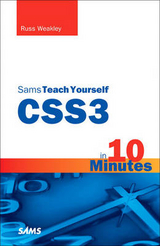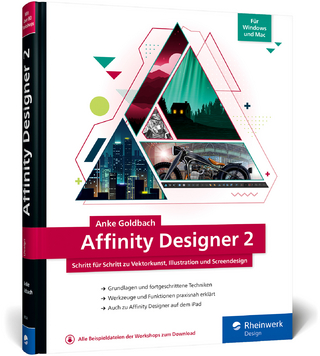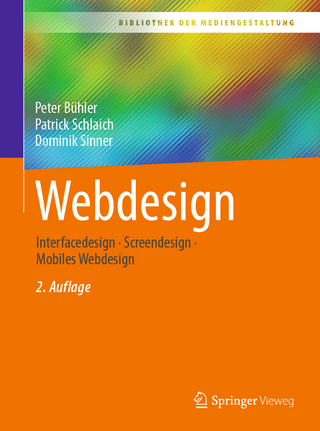
Sams Teach Yourself CSS in 10 Minutes
Sams Publishing (Verlag)
978-0-672-32745-2 (ISBN)
- Titel erscheint in neuer Auflage
- Artikel merken
The short, focused lessons presented in Sams Teach Yourself CSS in 10 Minutes will help you quickly understand cascading style sheets (CSS) and how to immediately apply it to your work. Author Russ Weakley is a well-respected member of the CSS community and is known for his ability to make complicated concepts easy-to-understand for even inexperienced CSS users. With this book, you will cover the essentials for standards compliant techniques that are supported by the most common browsers. Once you master the basics, Weakley will also take you inside positioning, troubleshooting CSS, and handling common CSS bugs. Sams Teach Yourself CSS in 10 Minutes is the ultimate quick learning tool and handy desk reference guide to CSS.
Russ Weakley has worked in the web design field for over 18 years. He is one of the principals for MaxDesign, a highly respected Australian design house. Russ currently is co-chairman of the Australian Web Standards Group, through which he assists web developers in understanding a variety of new technologies. He also is well-known in the CSS community for his CSS-based showcases and tutorials.
Introduction.
Who Is This Book For?
How This Book Works.
Online Support Files.
Conventions Used in This Book.
1. Understanding CSS.
What Is CSS?
What Does Cascading Mean?
Why Use CSS?
2. Using CSS Rules.
Setting Up the HTML Code.
Creating a Rule Set.
Using Multiple Declarations.
Combining Selectors.
Using Shorthand Properties.
Using Shorthand Borders.
Using Shorthand Margins and Padding.
Other Shorthand Properties.
3. Selectors in Action.
Setting Up the HTML Code.
Type Selectors.
Class Selectors.
ID Selectors.
Descendant Selectors.
Universal Selectors.
Advanced Selectors.
4. Applying Styles.
Setting Up the HTML Code.
Applying Inline Styles.
Using Header Styles.
Using External Style Sheets.
@import Styles.
Hiding Styles from Older Browsers.
5. Getting to Know the CSS Box Model.
Understanding Inline and Block Level Elements.
Setting Box Width.
Margins.
Background Color and Background Image.
Padding.
Border.
Content Area.
6. Adding Background Images.
Setting Up the HTML Code.
Creating Selectors to Style the Header.
Adding background-image.
Setting background-repeat.
Adding background-position.
Using the background Shortcut.
Adding padding.
7. Formatting Text.
Setting Up the HTML Code.
Removing Font Elements.
Creating the Selectors.
Styling the Element.
Styling the First Paragraph.
Converting to Shorthand.
8. Styling a Flexible Heading.
Styling the Heading.
Adding Color, Font Size, and Weight.
Setting Text Options.
Applying Padding and Borders.
Adding a Background Image.
9. Styling a Round-Cornered Heading.
Styling the Heading.
Styling the Element.
Adding a Background Image.
Styling the Element.
10. Styling Links.
Links and Pseudo-Classes.
Setting Pseudo-Class Order.
Using Classes with Pseudo-Classes.
Styling Links with Background Images.
Removing Underlines and Applying Borders.
Increasing the Active Area of Links.
11. Positioning an Image and Its Caption.
Wrapping the Image and Caption.
Floating the Container.
Applying Padding, Background Color, and a Background Image.
Styling the Caption.
Styling the Image.
Creating a Side-By-Side Variation.
Creating a Photo Frame Variation.
12. Creating a Photo Gallery.
Creating a Thumbnail Gallery.
Positioning the Elements.
Styling the Image.
Styling the Paragraph Element.
Forcing a New Line.
Creating a Side-By-Side Variation.
13. Styling a Block Quote.
Applying the Element.
Styling the Element.
Styling the Paragraph.
Styling the source Class.
Creating a Variation.
14. Styling a Data Table.
Starting with a Basic Table.
Adding Accessibility Features to a Data Table.
Creating Selectors to Style a Table.
Styling the Caption.
Styling the Element.
Styling the and Elements.
Styling the Element.
Targeting Instances of the Element.
Creating Alternate Row Colors.
15. Creating Vertical Navigation.
Why Use a List?
Styling the List.
Styling the
Element.
Styling the Element.
Adding a Hover Effect.
Styling the Element.
16. Creating Horizontal Navigation.
Styling the List.
Styling the
Element.
Styling the Element.
Styling the Element.
Styling the :hover Pseudo Class.
Summary.
17. Styling a Round-Cornered Box.
Setting Up the HTML Code.
Creating the Illusion of Round Corners.
Creating Selectors to Style the Round-Cornered Box.
Preparing the Images.
Styling the Element.
Styling the Element.
Styling the Element.
Styling the .furtherinfo Class.
Styling the Element.
Creating a Fixed-Width Variation.
Creating a Top-Only Flexible Variation.
18. Creating a Site Header.
Setting Up the HTML Code.
Creating Selectors to Style the Header.
Styling the Element.
Styling the Container.
Styling the Element.
Styling the Element.
Styling the
Element.
Styling the Element.
Styling the Element.
19. Positioning Two Columns with a Header and a Footer.
Setting Up the HTML Code.
Creating Selectors to Style the Two-Column Layout.
Styling the Element.
Styling the Container.
Styling the Element.
Styling the #nav Container.
Styling the
Element.
Styling the Element.
Styling the #content Container.
Styling the #footer Container.
Styling the Element.
Styling the Element.
20. Styling a Page for Print.
Setting Up the Print CSS.
Starting with Existing HTML and CSS Code.
Creating Selectors to Style for Print.
Styling the Element.
Styling the Element.
Styling the #nav Container.
Styling the #footer Container.
Styling the Element.
21. Positioning Three Columns with a Header and a Footer.
Setting Up the HTML Code.
Creating Selectors to Style the Three-Column Layout.
Creating a Liquid-Layout Grid.
Creating the Background Images.
Styling the Element.
Styling the Element.
Styling the and Elements.
Styling the First Container.
Styling the Second Container.
Styling the #content Column.
Styling the #news Column.
Styling the #nav Column.
Styling the
Element.
Styling the #footer Element.
22. Troubleshooting CSS.
Setting Up the CSS Code.
Fixing the Problems.
Some Tips for Troubleshooting CSS Problems.
Index.
| Erscheint lt. Verlag | 17.11.2005 |
|---|---|
| Verlagsort | Indianapolis |
| Sprache | englisch |
| Maße | 138 x 209 mm |
| Gewicht | 286 g |
| Themenwelt | Mathematik / Informatik ► Informatik ► Grafik / Design |
| ISBN-10 | 0-672-32745-7 / 0672327457 |
| ISBN-13 | 978-0-672-32745-2 / 9780672327452 |
| Zustand | Neuware |
| Informationen gemäß Produktsicherheitsverordnung (GPSR) | |
| Haben Sie eine Frage zum Produkt? |
aus dem Bereich



